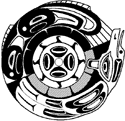
Phases of the Moon:
Planetarium show for Middle School Children
Post-Show Activity 1
Venn is the Summer Moon
Objectives
Students will place phrases and words from the Moon article into a Venn diagram.
Grade Level
1 - 4
Materials
Summer Full Moon story (below)
Background
Students should have some understanding of what a Venn diagram is and what it is used for.
Procedure
- Start off by discussing the full moon. Ask students to tell you their experiences with full moons and to describe characteristics of a full moon.
- Draw a Venn diagram on the board or overhead. Ask students if they are familiar with Venn diagrams. If the concept seems new, do a sample Venn diagram using two students names from the class.
- Distribute the activity sheet and read the directions. Read through the list of words and phrases, define any that students ask you to define. Monitor students as they work in pairs or individually.
- Discuss the results briefly and then read the story as a class or individually. Review the Venn diagram and see if the story information changed any of the diagrams.
- Discuss the reading further. Questions might include: What is the summer solstice? Why does the moon appear larger on the horizon? What causes the light and dark areas on the face of the Moon? Where did the Moon come from?
- An extension of this activity would be to have pairs of students develop a two minute commercial advocating that everyone go out and watch the Summer Solstice Full Moon.
Summer Full Moon
A bright full Moon makes a pretty night. As you look at the full Moon, you can see the shapes that make up the face of the 'man in the Moon.' Those shapes are craters from asteroid crashes, lava fields and mountains. You can even see the large dark area where astronauts landed and explored!
The biggest-looking full Moon of this year will brighten the night sky on the weekend of Friday June 16, 2000. This full Moon will be just 4 days before the longest day of the year. On the longest day of the year, the Earth is tilted toward the Sun. The sun shines bright and it is high in the sky. The Moon also shines brightly, but stays low in the sky.
When the Moon is low in the sky, it looks bigger. When the Moon is low in the sky, it looks like it is close to the farthest part of the Earth that you can see, which is called the horizon. A Moon near the horizon seems much larger than a Moon that is high on the sky. That is because your eyes are playing tricks on you! When the Moon is low, your brain makes it look bigger.
When your eyes and brain fool you, it is called an optical illusion. You can make the illusion go away by looking at the Moon through a tube. Take the inside of a toilet paper roll or paper towel roll and save it until the Moon comes up. Look at the Moon with just your eyes and notice how big it is. Now look through your tube. Did the Moon just get smaller? You just tricked your tricky brain!
A bigger Moon is even more interesting to see.The light areas are old hills that have many craters. The dark areas, called seas, are giant craters the were later filled with lava. Most of the Moon is covered with a mixture of fine dust and rocks.
The big Moon may also have pretty colors. The summer full Moon may seem to be pink or orange as it hangs close the horizon. The dust in the atmosphere might make the Moon have the same colors as a pretty sunset.
The full Moon is always beautiful. This Moon will be even more beautiful because it will be bigger and more colorful than most full Moons. Stay up until sunset and have a Moon party. What will you see?
